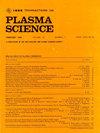Precision Airflow Control via EHD Actuator: A Co-Simulation and Control Design Case Study
IF 1.3
4区 物理与天体物理
Q3 PHYSICS, FLUIDS & PLASMAS
引用次数: 0
Abstract
A dielectric barrier discharge (DBD) plasma actuator for controlling airflow is proposed. It consists of diverging and converging nozzles, two concentric cylinders, and an actuator mounted in between the two cylinders. The actuator employs electrohydrodynamic (EHD) body force to induce an air jet within the air gap between the two cylinders, effectively creating a suction area while passing through the diverging nozzle, due to the Coanda effect. While merging with the air stream inside the inner cylinder, the Coanda jet effectively enhances the amplification of the airflow. The outflow rate is measured by a velocity sensor at the outlet and controlled by the plasma actuator. The control strategy is based on the active disturbance rejection control (ADRC) and compared to the baseline PID controller. The actuator was modeled by seamlessly linking two modeling platforms for a co-simulation study. The computational fluid dynamic (CFD) simulation of the plasma and airflow was carried out in the COMSOL multiphysics commercial software, and the control was implemented in Simulink. The DBD plasma model was based on the two-species model of discharge, and the electric body force, calculated from the plasma simulation, was used in the Navier-Stokes equation (NS) for the turbulent flow simulation using通过 EHD 激励器实现精密气流控制:协同仿真与控制设计案例研究
本文提出了一种用于控制气流的介质阻挡放电(DBD)等离子体致动器。它由发散和会聚喷嘴、两个同心圆柱体和安装在两个圆柱体之间的致动器组成。致动器利用电流体动力(EHD)体力在两个气缸之间的气隙中诱导气流喷射,由于科恩达效应,在通过发散喷嘴时有效地形成了一个吸气区。在与内圆筒内的气流汇合时,科恩达射流有效地增强了气流的放大作用。流出速度由出口处的速度传感器测量,并由等离子致动器控制。控制策略基于主动干扰抑制控制(ADRC),并与基准 PID 控制器进行了比较。通过无缝连接两个建模平台对执行器进行建模,以进行协同仿真研究。等离子体和气流的计算流体动力学(CFD)模拟是在 COMSOL 多物理场商业软件中进行的,而控制是在 Simulink 中实现的。DBD 等离子体模型基于双种放电模型,等离子体仿真计算出的电体力被用于纳维-斯托克斯方程(NS),使用 $k-\omega $ 模型进行湍流仿真。利用输入(致动器电压)和输出(出口流速)数据对等离子气流系统进行了分析,以便进行控制设计。最后,在协同仿真过程中对气流控制装置系统的性能进行了测试和讨论。
本文章由计算机程序翻译,如有差异,请以英文原文为准。
求助全文
约1分钟内获得全文
求助全文
来源期刊

IEEE Transactions on Plasma Science
物理-物理:流体与等离子体
CiteScore
3.00
自引率
20.00%
发文量
538
审稿时长
3.8 months
期刊介绍:
The scope covers all aspects of the theory and application of plasma science. It includes the following areas: magnetohydrodynamics; thermionics and plasma diodes; basic plasma phenomena; gaseous electronics; microwave/plasma interaction; electron, ion, and plasma sources; space plasmas; intense electron and ion beams; laser-plasma interactions; plasma diagnostics; plasma chemistry and processing; solid-state plasmas; plasma heating; plasma for controlled fusion research; high energy density plasmas; industrial/commercial applications of plasma physics; plasma waves and instabilities; and high power microwave and submillimeter wave generation.
 求助内容:
求助内容: 应助结果提醒方式:
应助结果提醒方式:


